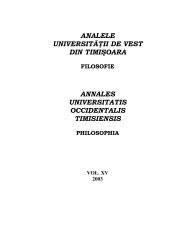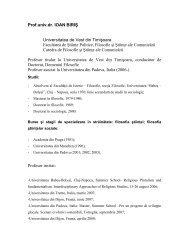VOL. IV (XXI) 2009 - Departamentul de Filosofie si Stiinte ale ...
VOL. IV (XXI) 2009 - Departamentul de Filosofie si Stiinte ale ...
VOL. IV (XXI) 2009 - Departamentul de Filosofie si Stiinte ale ...
You also want an ePaper? Increase the reach of your titles
YUMPU automatically turns print PDFs into web optimized ePapers that Google loves.
ADINA BAYA 97<br />
[…] I’ve been afraid for more than half my life. […] I wake up sweating. I<br />
break out in killer sweats.” 17 This anxiety ends up dominating their life to<br />
such an extent, that they both wind up doing <strong>de</strong>sperate acts in an attempt at<br />
its annihilation. Babette enters an experimental program for Dylar, a drug<br />
that is supposedly meant to alleviate her necrophobic fears, taking the risk of<br />
<strong>de</strong>veloping a daunting set of <strong>si</strong><strong>de</strong> effects. When the program is <strong>de</strong>emed<br />
unsuccessful and suspen<strong>de</strong>d, she resorts to a promiscuous strategy to<br />
continue receiving the drug. In his own search for obliterating his fear of<br />
dying, Jack also gets caught up in an expectedly brutal context, ending up<br />
with an attempt to kill Willie Mink, Babette’s supplier of Dylar.<br />
The cultivation of an “irrational dread of dying” and its ensuing<br />
“diminished vitality and self-direction in life” are regar<strong>de</strong>d by George<br />
Gerbner 18 as a result of the symbolic function of <strong>de</strong>ath in prime time media.<br />
Starting from the fact that news represents a selection of events from an<br />
otherwise endless stream of daily occurrences, Gerbner observes that “a<br />
narrative is invented to convey some meaning about the selected facts as<br />
interpreted in a previously learned framework of knowledge.” This strategy<br />
works because televi<strong>si</strong>on is the “universal story-teller of mo<strong>de</strong>rn society,”<br />
generally used by audiences for this purpose and without too much<br />
questioning or disbelief. It is in this narrative frame of daily news that <strong>de</strong>ath<br />
and the contexts that lead to it are used as a means of typing and confirming<br />
the stereotypes previously put forward by the media. Death here is always<br />
framed as a “<strong>si</strong>gn of fatal flaw or ineptitu<strong>de</strong>, a punishment for <strong>si</strong>ns or mark of<br />
a tragedy,” and its customary use has the aim to remind viewers “the risks of<br />
life” and to cultivate “anxiety and <strong>de</strong>pen<strong>de</strong>nce for those who are <strong>de</strong>picted as<br />
most at risk.” According to Gerbner, <strong>de</strong>ath in the news cultivates “insecurity,<br />
anxiety, fear of the ‘mean world’ out there, and <strong>de</strong>pen<strong>de</strong>nce on some strong<br />
protector,” thus resembling the “bread and circuses” strategy used by the<br />
Roman Empire to keep populations quiet and un<strong>de</strong>r control. He conclu<strong>de</strong>s<br />
that “the symbolic function of <strong>de</strong>ath in the world of televi<strong>si</strong>on is […]<br />
embed<strong>de</strong>d in its structure of violence, which is essentially a show of force,<br />
the ritualistic <strong>de</strong>monstration of power.” 19<br />
The fact that in White Noise Babette seems to be more affected by<br />
exposure to a media environment permeated by <strong>de</strong>ath, <strong>de</strong>veloping a<br />
paralyzing fright in connection with her finitu<strong>de</strong>, is also explainable through<br />
the research conducted by Gerbner. His analy<strong>si</strong>s of the <strong>de</strong><strong>si</strong>gnated victims<br />
and aggressors presented typically in prime time shows that women and<br />
minorities involved in violence are prev<strong>ale</strong>ntly presented as most<br />
vulnerable 20 . The researcher sees <strong>de</strong>ath on televi<strong>si</strong>on as “a violent<br />
17<br />
DeLillo, 1986, p. 89.<br />
18<br />
George Gerbner, “Death in Prime Time: Notes on the Symbolic Functions of Dying<br />
in the Mass Media” in Annals of the American Aca<strong>de</strong>my of Political and Social<br />
Science, vol. 447, Jan. 1980<br />
19<br />
Gerbner, 1980, p. 66.<br />
20<br />
Gerbner, 1980, p. 67.




